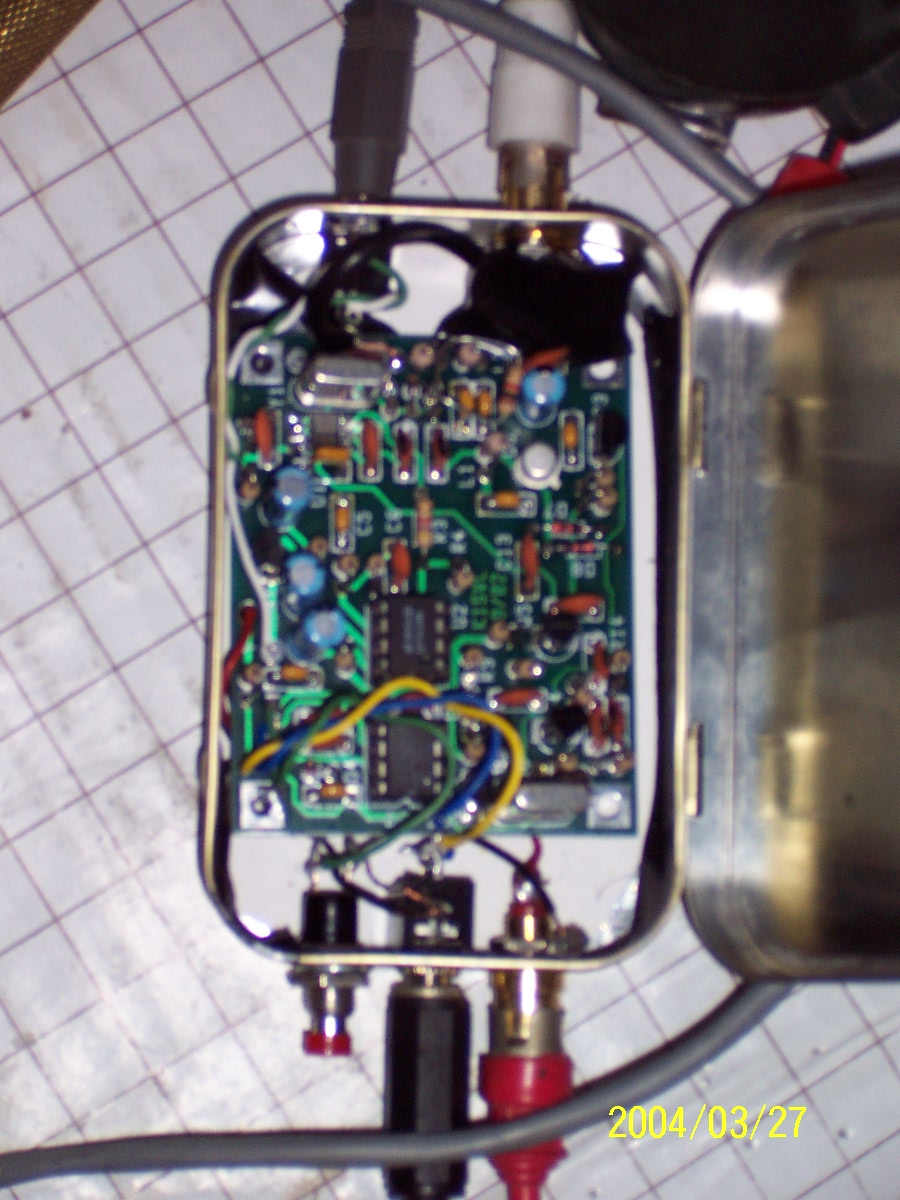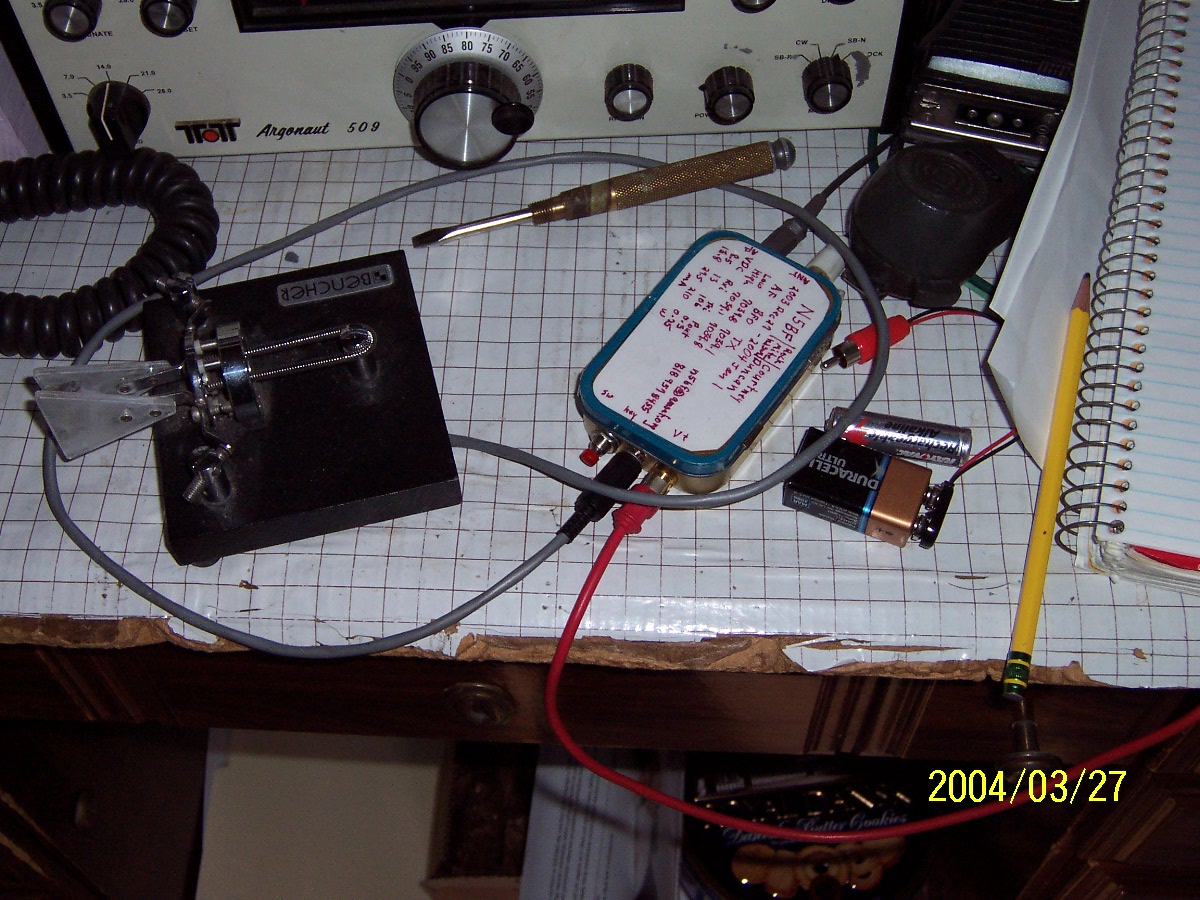Utility Radio
back to ham
radio
created 2011 June 30
made subordinate to DSP-10 Legacy 2013 August 31 cbd
Projects that aren't part of Research Radio but still have to do
with being on the air in some sense.
2003 Christmas: RockMite
I built a 40 meter RockMite over 2003 Christmas Holidays and for a time
didn't want
to operate anything else!
Now it's packed away in the garage somewhere.
But see this.
2010 January 9 - Begin Mobile Radio
Research
Read up on the standard mobile rigs: Yaesu FT-857, ICOM
IC-7000, and Kenwood TS-480. The IC-7000 looked more expensive at
first but it was really the only choice. There was nothing
additional to buy: TCXO, filters, etc., it was all included stock.
Less clear on how to proceed for antennas, GPS, and APRS. But one
thing - I just wanted one radio blaring. None of this "several
sources of white noise" business.
Wanted everything permanent - NMO. No wires going through windows
or trunks. No magmounts.
2010 March 31 - More Research
How about a power system? Bumper mount for HF? Turnkey APRS
system. What to do about a 6 meter antenna. What about 160?
2010 May 25 - First Orders Start
Coming In
2010 May 26 - Unpack the IC-7000
Make up power poles on its power chord and start
kerchunking repeaters.
2010 May 31 - The Installation in
Earnest
Install an APO3 under the
hood, input from the fuse block, set to shut off ten minutes after
voltage drops below 13.05 volts.

Will also set the IC-7000 to shut off after 60 minutes of inactivity.
Pulled the main 30A power cable into the cab. Fishing for this is
always the hardest part.
Do the first NMO antenna install, the one that will be used for
APRS. Screw on the antenna and verify (Bird 10C and IC-T81A) that
it loads correctly with the truck doors shut.

Installed the Byonics RTG.
Expect now to get positions while underway and for ten minutes after
stopping anywhere. This should give a good chance of termination
locations. (N5BF-3)
2010 June 4 - HF Research
Research HF antennas and tuners. Think I might just use the Hustler
stuff that I have and use an auto-tuner to tune it like it was a
whip. Ordered an SG-237 tuner.
2010 June 8 - Memories
Stated putting local repeaters into IC-7000 memories per the
manual. Drove up to Cerro Negra and checked into PERCS
on 144.465 FM.
2010 June 12 - Fit Check the Tuner and
Ball Mount
2010 June 18 - HF Installation
It was necessary to (go to the store and get a bigger mandrel
that wouldn't fit in my hand drill to hold the big hole saw and then)
use the drill press to drill the big hole.


2010 June 19 - Mounting the Radio
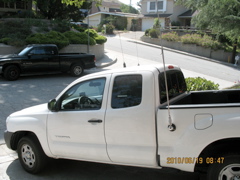
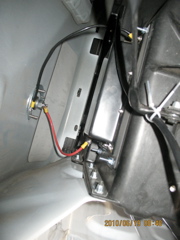


2010 July 1 - Install KG6HUI-3
in the Mazda
2010 July 2 - Install WD5EHM-3
in the Hyundai
This multiple hour installation of a Byonics RTG with magmount system
involved the most difficult power cable route I've ever done on a
vehicle.
2010 November 28 - Top Band
Swan Conversion
Opened a new category; Utility '8' (BWT is '2') to help track utility
radio tasks and operations so that they don't overwhelm research.
Take down IC-7000 from Swan hookup for SS Phone and put back in truck.
Attempt to convert Swan to Top Band for upcoming test. Problems
with making good connections - arcing on the terminal strip.
Haven't done this modification in several years. The directions I
left myself are not complete. Led to some philosophical thinking
about Top Band. I'm on here because it's the edge, because I read
Clinton DeSoto's book "200 Meters and Down." Is the band that
much "fun"? Do I want to talk to those people? Is it useful
for communications? Well, I did buy the GAP DX-IV so I could be
here, and it worked.
I'd really like an external switch capability to 160 so I'd never have
to open it up again for this mod and a T/R relay so I could hook up the
IC-7000 without two foot
switches. Gave up at 0100.
2010 December 3 Day of
the ARRL Top Band Contest
Try the 160 mod to the Swan again. Got it working but then
re-discovered that the input load doesn't work. Had used the
MFJ-941B tuner in the past. The MFJ has to be modified to do this
tuning on 160 also. Lid off - add capacitance. Only works
with lid off....
Generated the missing conversion documentation:
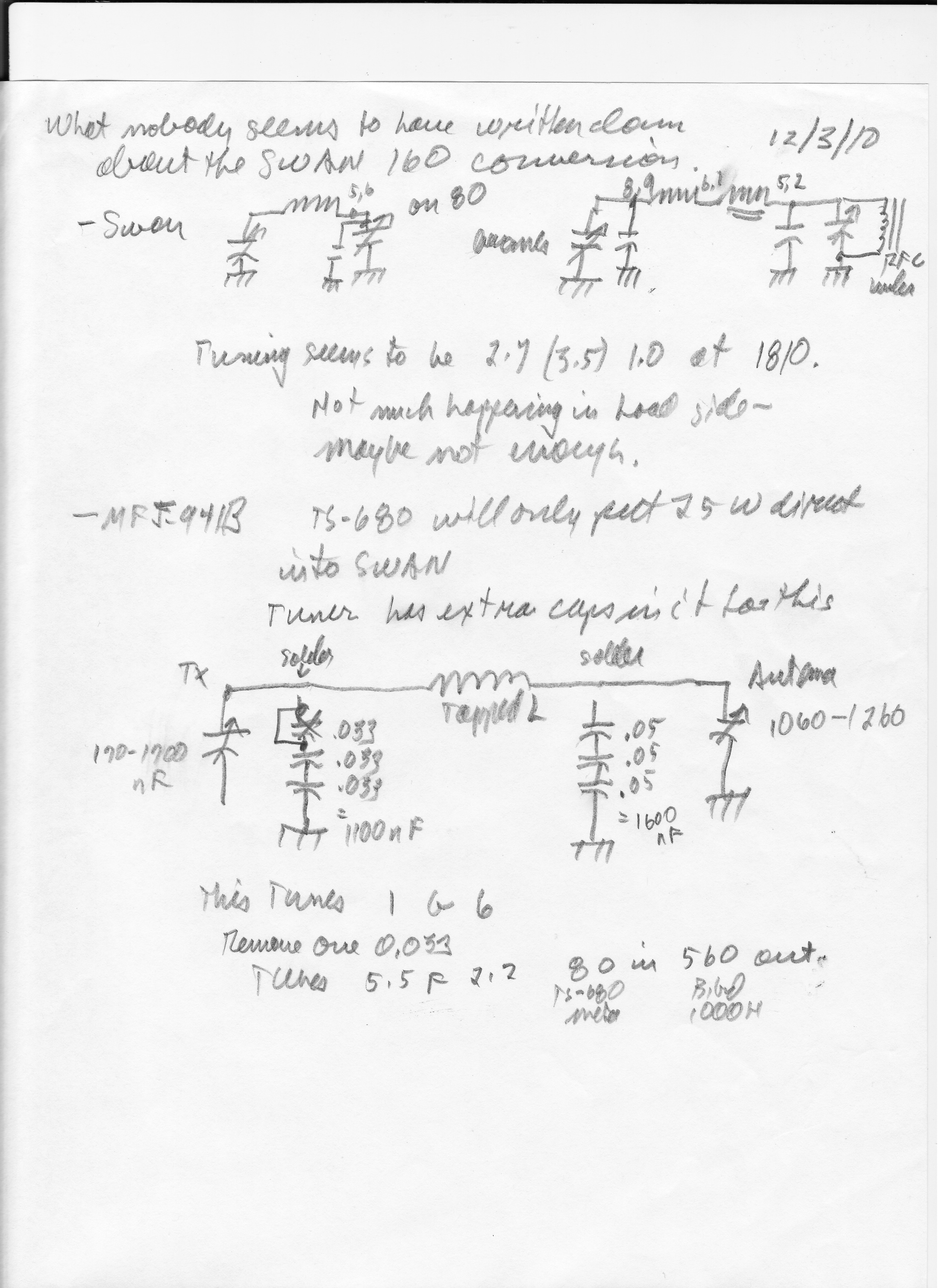
The operational setup

2011
February 12 -- PL in 1.3 meter rig, Midland 13-509, after
all these years
Added Communications Specialists TE-32 (top picture)
subaudible tone assembly to Midland 13-509. The digitally
generated tone had no audio processing. Getting the output set
right and the modulation input to the rig was challenging.
Checked and recorded crystal frequencies while I was in there.
Checked low and high power at about 1 an 10 watts respectively.
Hooked up through UHF coax switch to discone. Other end of switch
goes to FT-2800.
Ch
Tx Rx Heard
1 223.50 223.50 ARRL June VHF and FD QSOs, occasional ID by
local
2 222.44 224.04 123.0 W6JUN, mostly non-English
speakers. Used to be JPL pair
3 222.48 224.08 156.7 WR6JPL on nearby Cerro Negra
4 222.36 223.96 None
5 222.82 224.42 Heard AA6BP/R but could not hit @ 10 W.,
any PL setting.
6 223.34 224.94 None
7 223.93 223.94 None
8 empty
9 emtpy
10 empty
11 empty
12 empty
When I thought I was done, I called Bob, NO6B on the JPL
repeater. He
talked me in to the right deviation and PL settings so that I would not
talk it off but you couldn't quite hear the buzz. Thanks Bob.
I bought the rig used from a W6VIO (JPL ARC) club member at a garage
sale years ago. I do not know the history or intent of any but
channels 1-3.
Now I generally monitor 223.50 which is generally but not perfectly
quiet, unless I need to be on some other 144 or 222 channel. Made
several ARRL VHF QSO Party (2011 June 11) contacts and all FD contacts
(2011 June 25) on 223.50 FM.


2011 February 20 - IC-7000 low 70 cm
Power
My IC-7000 is one of those that originally put out only 18 watts on 70
cm. (Spec. is 35.) Took it out of the truck and sent it in
to ICOM for warranty repair before the one year warranty expired.
Swapped the FT-2800 into the truck to have at least two meters in the
interim.
2011 March 4 - IC-7000 Cleared Memories
Received the IC-7000 back and swapped it back into the truck.
Discovered that everything in computer memory was erased. Nearly
a year of channel collecting, etc.!
Decided that I probably had enough notes in my notebook/logbook to
reproduce most of what had been in at least the memories (but none of
the other settings, or voice recordings, or CW messages or DTMF
sequences!) and after some research ordered a Black Cat CIV Icom
Interface and downloaded some unsupported memory
management software from Dog Park. This is all pretty clunky
(not like just backing up your whole rig before resetting it) and
doesn't work right with the radio not connected up through the
interface, but did allow me to get most of the memories (like of
repeaters on my routes to Texas and back, plus locals) back in in about
three hours effort.
After the next disaster:
2011 March 7 - IC-7000
smoked right after I parked the truck at home
Smoke coming out the fan hole. All power outputs droppped into
the 0 - 10 dBm (1-10 milliwatt) level. Could still hit the 445.2
JPL repeater about a mile away. That was it. Swapped the
Yaseau back in. Slightly edited the cover letter and mailed the
IC-7000 back to ICOM. Had to go to the M^2 open house without it.
2011 March 19 - M^2 Annual Open House
in
Fresno
Left work early on Friday (well, 3:30, after a 50 hour
week...) Viann left work earlier than I did (by APU standards),
about 4:30. We met at Starbucks where Viannah works, left her the
car, and drove off to Fresno in the truck. It's about five hours
counting a dinner stop.
It rained on us some on the way up and some on the way back Saturday
and most of the night while we were there. Some of the rain was
pretty heavy, most of it was not.
Pretty drive, if you don't do it very often.
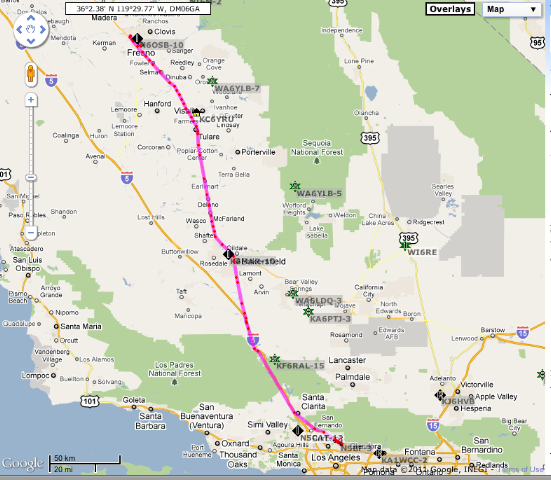
Slept in at the hotel and got to the bash kind of late. They open
at
8:00 and we got there about 11:00. This was just about right as
it
turns out.
There were plenty, like 8-10, cars and trucks with wild antennas on
them parked within two or three blocks. Makes my truck look
pedestrian.
Lunch was free, provided, cooked, and served by the employees.
Burgers
and chile and drinks for whoever shows up. I'd estimate about 300
in
attendance. Some were already leaving at 11:00 but most stayed
until
after the raffle. It was pretty much over by 3:00, though the
flyer
said 4:00. Don't show up too late
to these things.
The raffle featured gift certificates as high as $150 from both Yaseau
and M^2. Not winning anything myself I bought a T-Shirt.
"Official
Field Test Engineer." ($15)
One person had walked into the VE testing session that morning, a 10
year old girl who was there with her already licensed parents.
She
passed her Tech. One of the old guys, when his his raffle ticket
was
drawn, gave it to her, then she herself won the very next draw!
My kid's licenses all expire this summer. Yes it has been ten
years!
John is 20! I have Viannah on the ULS system working the issue.
M^2 a mom and pop shop, literally. Mike
and Myrna. (M^2, get it?) 15 employees, all pretty
specialized and
all pretty busy.
They have a nice solution to the "coax drooping down from crossed
yagis" problem. (Ray Soifer and I are skeptical about the real
benefit
of circular polarization these days, however.)
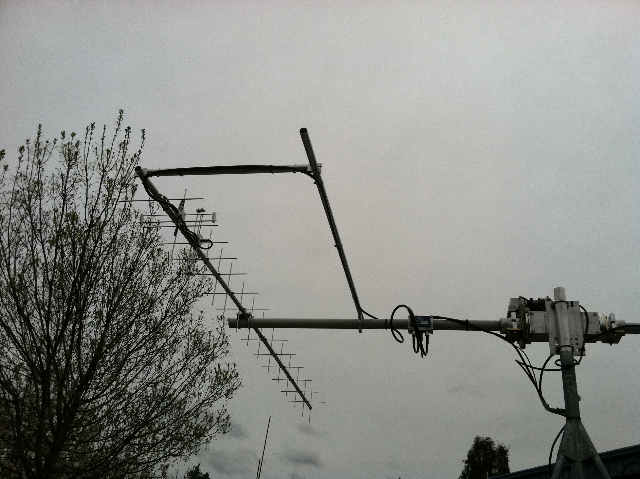
Answer to Jan's question (wind resistant antennas): They have
models that are spec. up to 125
mph. They have pictures of antennas that have been bent but not
broken
or (otherwise) destroyed in extreme winds. They actually model
for
this and reinforce with concentric tubing up to the rating.
Hint:
Whatever your antenna, if you park it orthogonal to the wind (if you
know the wind direction) you will do a lot better.
I know, it's hard enough to get W6VIO operators to turn off the radios
and return the coax patch panel to "disconnected" without asking them
to park the beams at a certain heading, but for $1000+ per windstorm we
could at least post a sign on the rotator.
Answer to Paul's question: (cost of az/el rotator systems)
Wyatt: "We
can't touch $200 in California (i.e. without going offshore to slave
labor). Our OSHA insurance for 15 people is $6000 a month.
Way too
much overhead (he quoted 47%, I don't know if he was serious).
Yaesu
makes an OK product. The pots wear out. The big bearings
wear out.
The M^2 elevation rotator is about $1400. Worm gears.
Magnet
counters. Nice work but kinda steep. Could one consider
such a thing
a "lifetime" investment? For az/el one needs two.
They had the machines set up doing boom drilling and aluminum block
hogging. I had a long discussion with one of the operators (a
girl of
about 30, looked like she was trained in the equivalent machine shop in
the Navy) about the equipment and techniques. Makes my drill
press
seem kind of pedestrian.
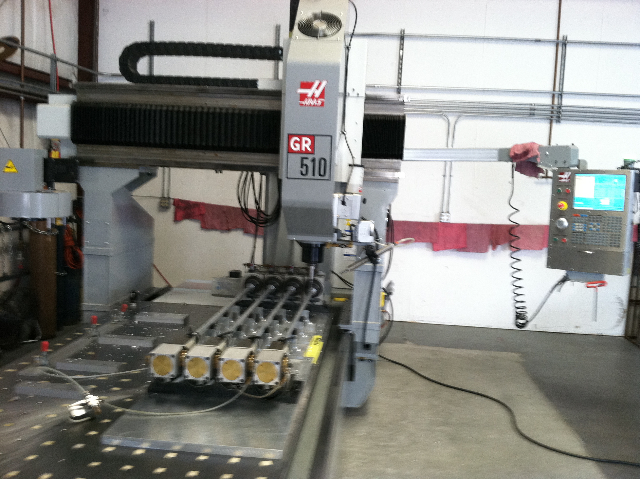
I got a picture with a 2-meter helix!
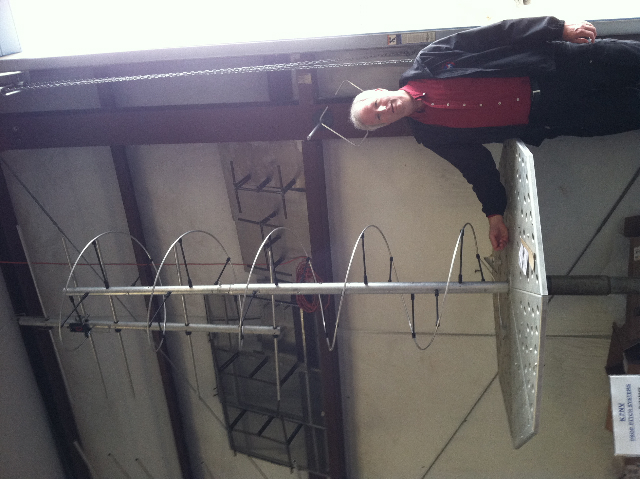
I most enjoyed the barrels full of boom and element parts and the
stacks of antennas in tiny boxes (1 meter by 4 cm by 4 cm typically)
ready to be shipped.
My question for next year (credit SBMS): Do you guys optimize for
forward gain or small sidelobes, i.e., minimum receive noise?
2011 March 24 - Tacoma Mobile Restored
IC-7000 back in truck and spent the three hours getting the memories
programmed back into it. It runs pretty hot when I talk a lot,
but hasn't burned up again (as of 2011 July 7).
2011 November 30 - 6-Position
Bandswitch on Swan MK-II
Put a 6-position bandswitch in the Swan MK-II. After 13 years of
opening the thing up every November and converting from 5-Band to
160-only by moving some high voltage jumpers around, then reversing the
process every December/January, I can now simply switch 160 meters
along with the other five bands. (Still have to open up the MFJ
941-B tuner and add some capacitance to both sides to load the rig into
it, but that's a different matter, see below.)
- It's the only wafer switch that MFJ sells and although not intended
for this particular amplifier, it was suitable for this circuit, if
tedious and a little ugly.
- Really sweated and double-triple-quadruple checked everything in the
tank circuit. All the taps had to be remade and the extra L and C
for 160 had to be rechecked and reinstalled in better ways than before.
- Used a bunch more of that HV wire I got free in 1998.
- Six band tests, all working OK. No HV shorts, RF arcs or any
such expected problems.
- Spent about as much time on this mod this year as I did on the jumper
conversions last year. (Long, long story.) Now I may never
have to open the amplifier up again! ... and that will be easier
on me and it.
In the not so good but interesting and time-consuming news, I abandoned
an attempt to make a PNP-NPN driver for the T/R relay so as to make it
key more universally with modern rigs. For instance, to use it
with the IC-7000 last year I had to use two foot switches, one for
each. This abandoned mod involved burning up a surge diode that I
added (it got white hot!) and the original equipment diode for the
realy half wave voltage rectifier. In the big save of the evening
(this happened right after Radio Shack closing hours) I went to the
garage and found an old, completely unmarked, full wave bridge that I'd
once used for a bicycle battery charger. Knowing that adjacent
wire pairs (of the four) would have suitable diodes in them, I tried
one and it worked first time. Got lucky with the polarity.
No damage to the ancient, and probably much harder to replace, T/R
relay coil.
Didn't even attempt adding anything for input loading except to repeat
the annual opening up of the MFJ-941B. Jan (WB6VRN) was over at
Thanksgiving and told me that people just use LDG auto-tuners between
their modern solid state rigs and these half-century old amplifiers
these days. The amps expect tank circuits before their inputs
from the 60s vintage exciters to give some freewheel action.
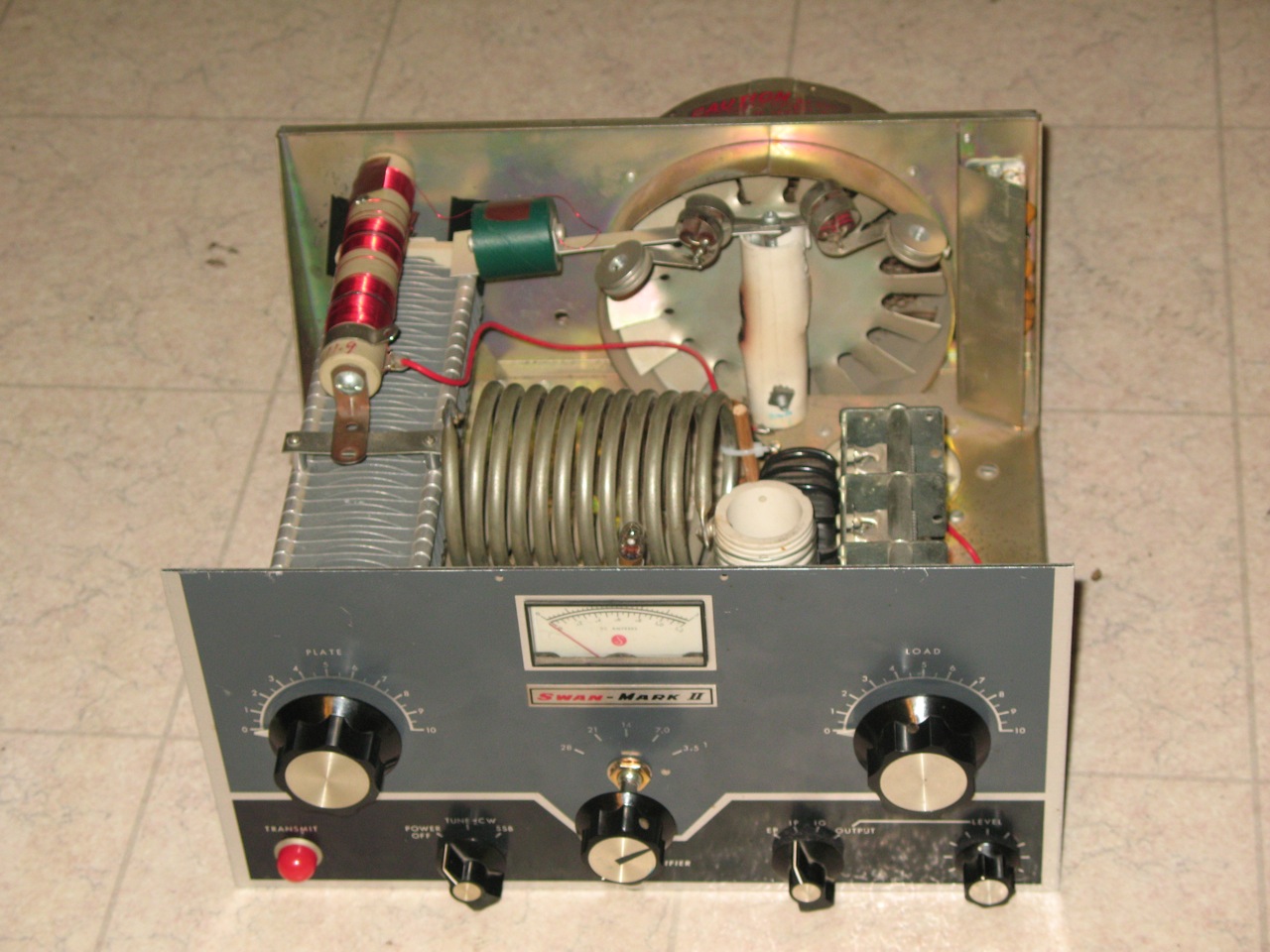
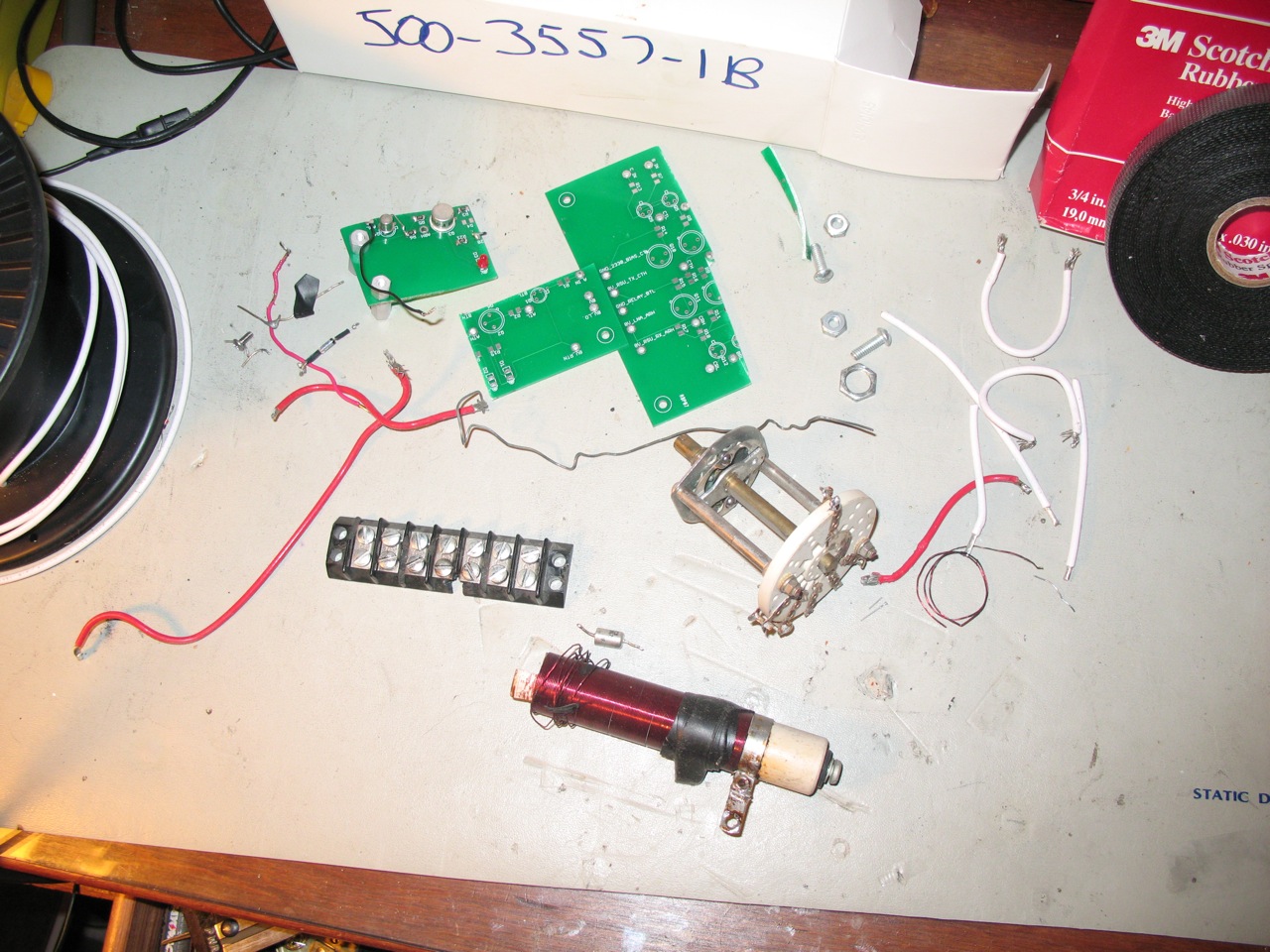
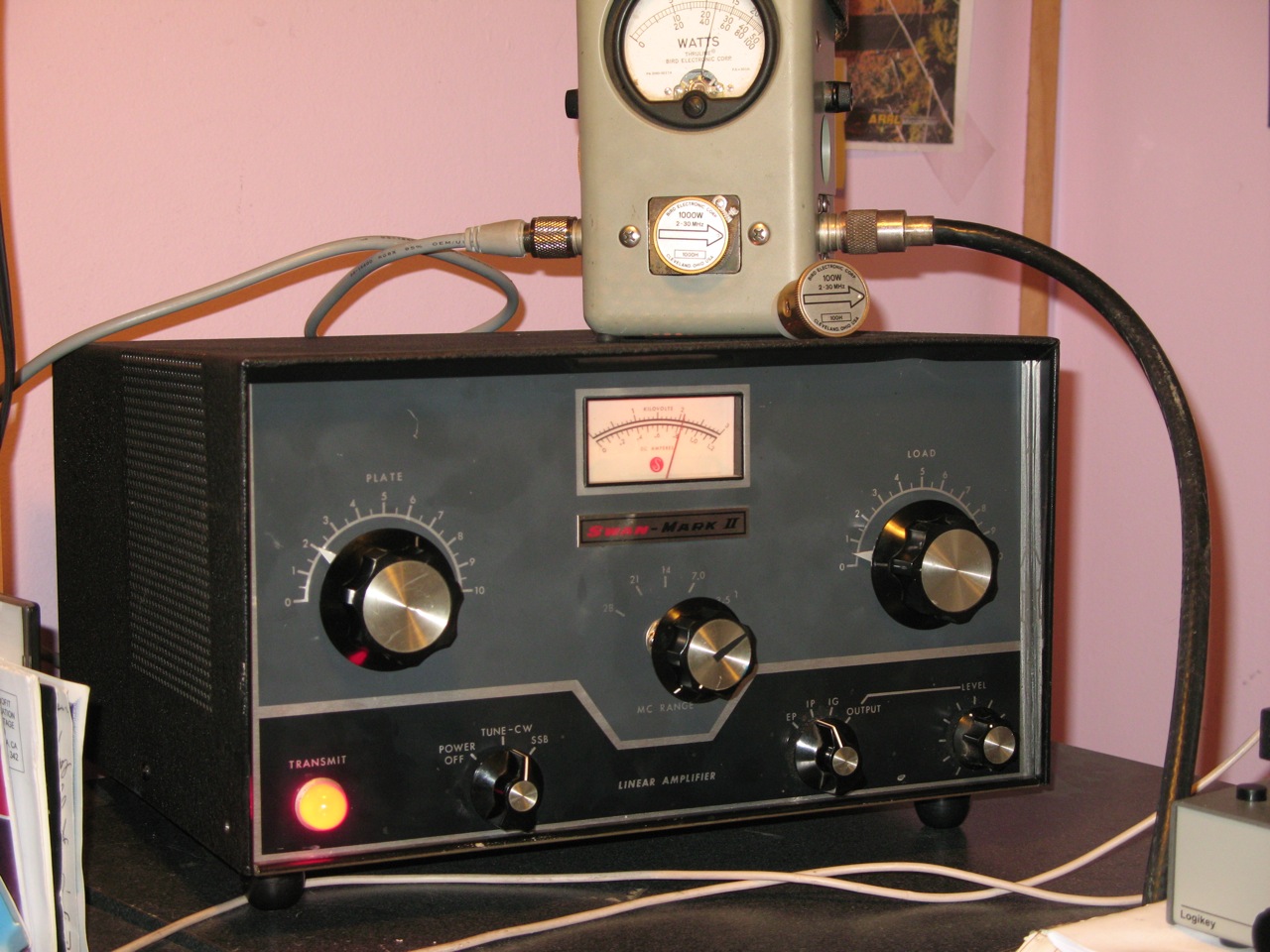
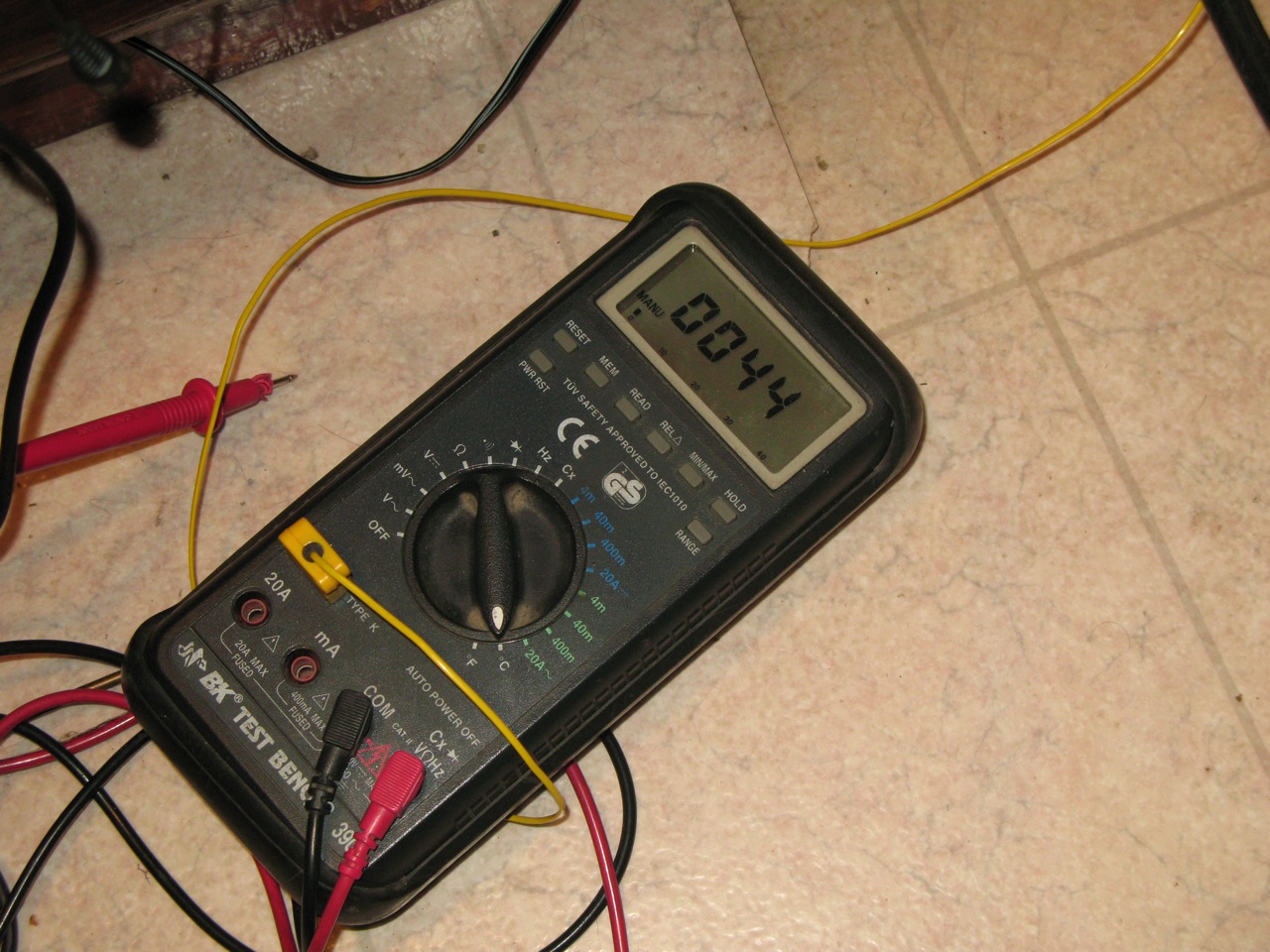
On contest day, I drove to HRO in Anaheim in holiday shopping traffic
and bought an LDG AT-200Pro II Autotuner to get the old manual MFJ
941-B out of the circuit, and an Ameritron 704-B to switch it. I can
either spend days and days trying to mod these circuits, or can spend
$39.95 on a solution that already works, given the right phono plug
connecting cables.
2011 December 13 - Station Mods for
the Swan Mod, Post Mortem, and 10-Meters
Well, the contest went great, the amp worked fine throughout, though I
was a little worried I was only getting 400 W out instead of the usual
600. I worked 80 something stations all over the place.
Best DX was Maine. Also worked XE2 for DX credit. It was
great for the 3-4 operating hours I was able to put into it.
I don't think I'll brag about the postmortem too publicly, however.
The first time I turned the amp on after the contest was over it would
only put out 200 watts and it wouldn't load from the new LDG tuner at
all like it had before. The tuner has memories and reads the
frequency and just clicks to the right place if it's ever been there
before, but now it was out of range. After about half an hour I
noticed that one of the tubes was dark, so I was loading up only one
tube.
That explains the half power and the tuning problems.
Dreams of buying some new 3-500Zs danced in my head....
One of the VHF bypass resistors had come unsoldered. Why that
makes the tube go totally dark I don't know, but I resoldered it, more
carefully this time, and swapped the tubes just to get a little socket
action. Also, while I was in there, noticed that one of the two
parallel extra loading capacitors for 160 wasn't grounded. So
that's why I was fully closing the load cap and only getting to 400
W. So I fixed that and buttoned it all back up.
It loaded fine and put the load capacitor at midrange on 160 and it put
out 600 W @ 1700 V and 800 W @ 3000 V so I was happy, but when I
started into the test sweep to see how all the other bands did it
started arcing. Diagnosing from the tuneup behaviors, I thought
the arcing was due to a cold solder on the newly installed 6 position
bandswitch. Sure enough, on inspection, there was a cold solder
in the suspect place, but putting it back in service it still
arc'd. By now I was pretty miffed. The contest weekend was
over so there was no incentive to work on this again for about 50
weeks, but durnit, the thing is sitting there not working right and an
earthquake might happen and I wouldn't be ready for maximum power then
what kind of ham would I be?!!
So I screwed around with it a bunch more, 9 post-contest hours total,
only about two of which I really had to spare (and this cut into my 10
meter contest operating time too!) After trying many things and
taking all 40 screws out of the bottom and looking for arcing evidence
there, finally noticed a not-cold solder wire tail sticking out of the
bandswitch and touching the corroded chassis. What had happened
was that I had a piece of HV tape under there but the wire was poking
it and finally, after about 48 hours, it punched through and shorted.
... so that's fixed and the amp works again.
And it's around 600 W out on 1700 V plate and around 800 on 3000 into a
dummy load (at 50C) on 160-15. I only get about 300 W on ten
meters because I run out of tune capacitor range on the low end which I
think I can fix by just spreading the spacing on the tank coil a little
on that end, but I don't have a KW antenna for ten meters so it's just
pride of workmanship to mess with that. And taking out and
putting back in six screws.
I use the MFJ loop on 10 and although it says it will do 300 watts I
just use it barefoot. I don't have a super station but did work a
bunch of South America, Prince Edward Island two or three times,
and Minnesota about forty. Where were these guys during SS?
It was like a pipeline to MN on CW and phone....
I'm reading the ARRL Handbook for Radio Communications chapter on
linears (Chapter 17 of the 2010 edition) and am really understanding a
lot of what they're saying now. Particularly about Class AB2
where you draw some grid current. That's why I've always had to
use a tuner on the exciter on 160 and 15, not because grounded grid
does that somehow but because the levels of grid current are just
setting the impedance out of the exciter foldback range. Jan,
WB6VRN, says you need a tank circuit in there to just smooth all that
out.
So here's a question. When/if you run AB1, it's high impedance
in. That would never match an untuned solid state exciter,
right? Do any amateur amps do that or do they go for the better
efficiency and match of AB2? In principle you could drive an AB1
amp to full power from a voltage source it would seem.
So I'm really happy with the LDG (now that I'm beginning to know how to
use it and understand what it does - I still need to read the manual)
and the ARB-704 (no manual necessary unless you want to get involved
with the ALC, which this Swan doesn't have). They just work and I
expect that they'll just work with the IC-7000 when I ever get around
to trying them again.
2012 July 13 Added APRS to the Ryan
Recumbent
Did some serious modelling with cocoaNEC
then proceeded to build a J-Pole on a safety flag, tune it up with some
difficulty, tape it up, and use it.
The rig is a Byonics AIO
(All In One)
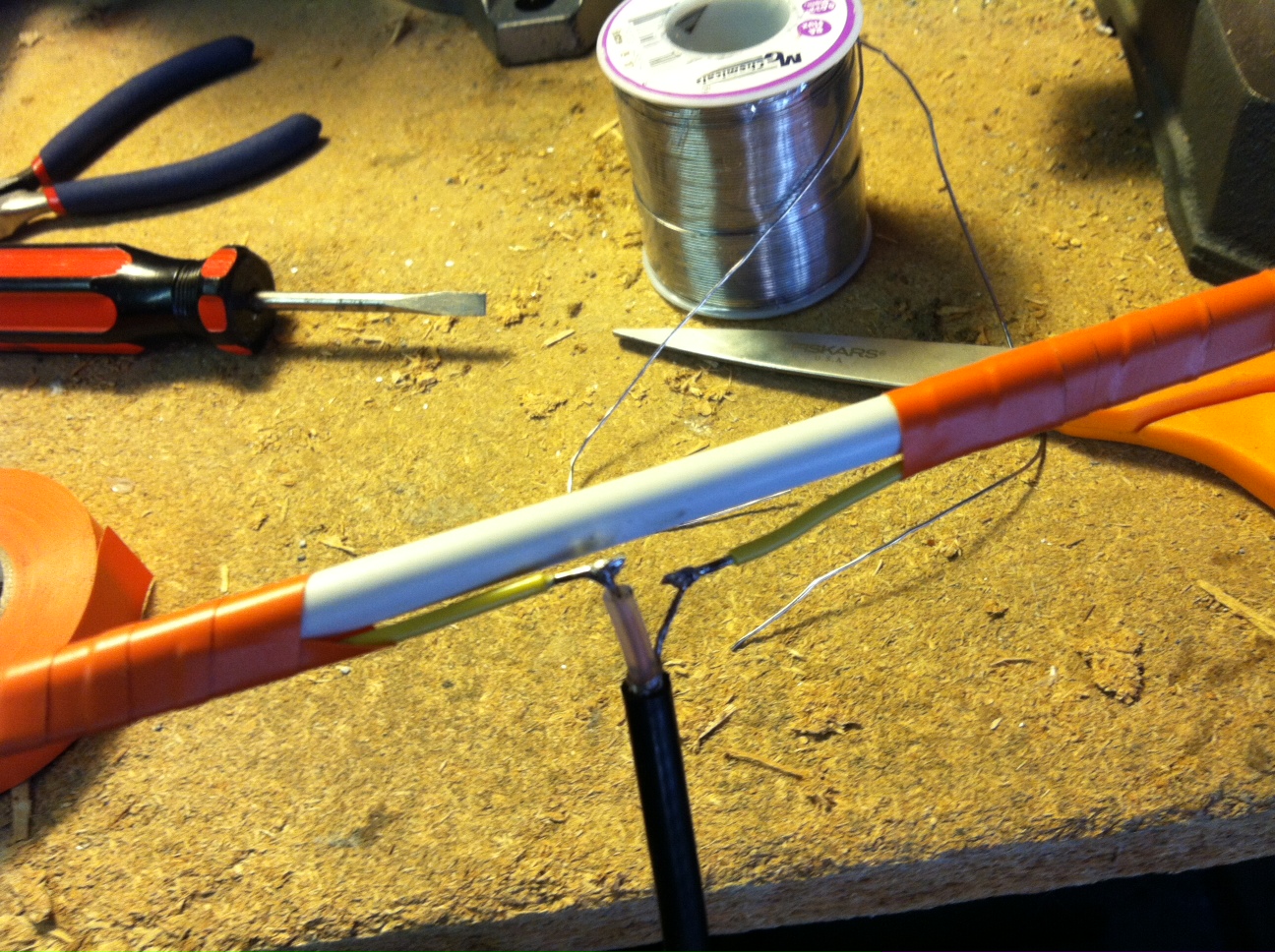
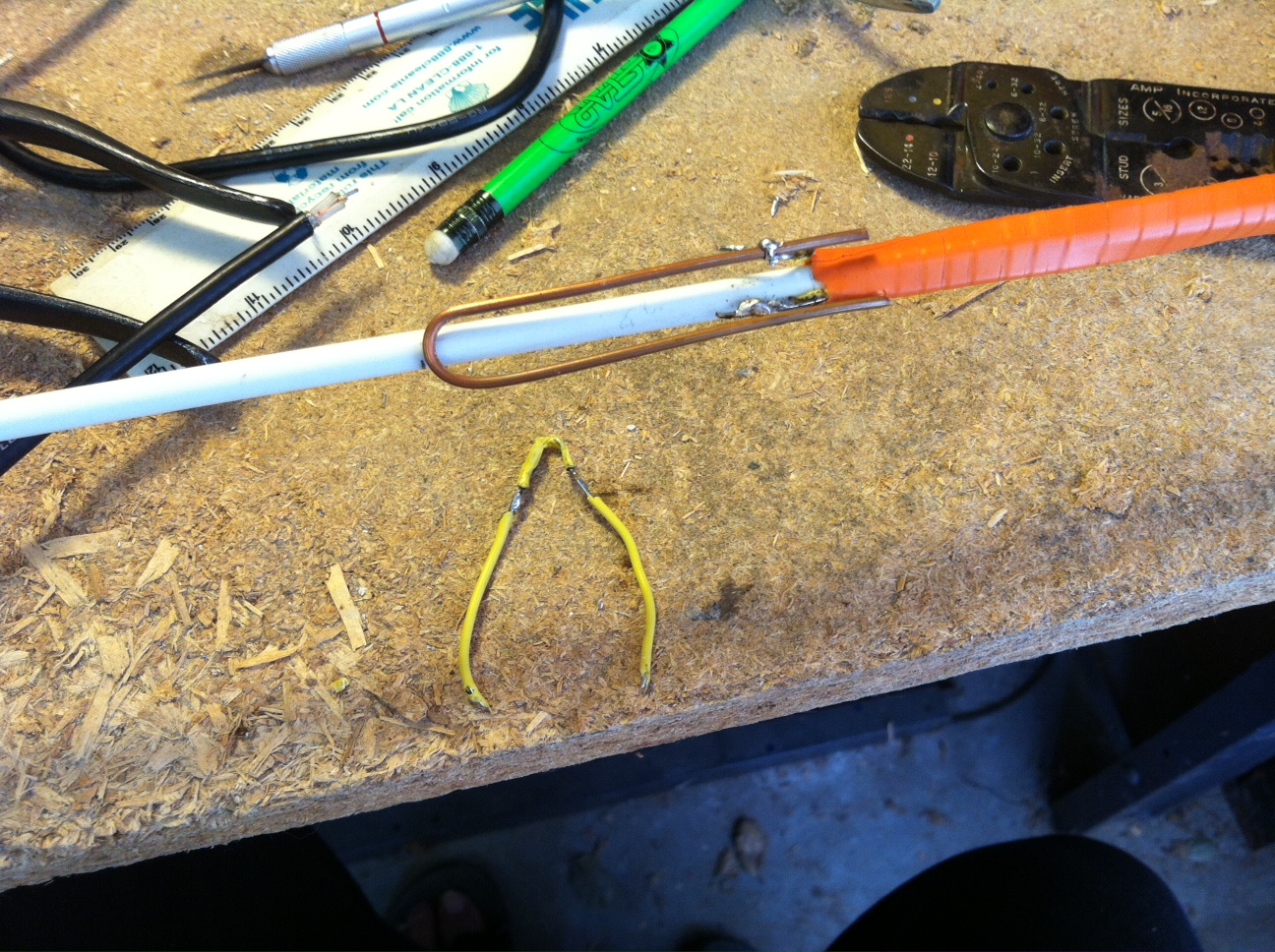
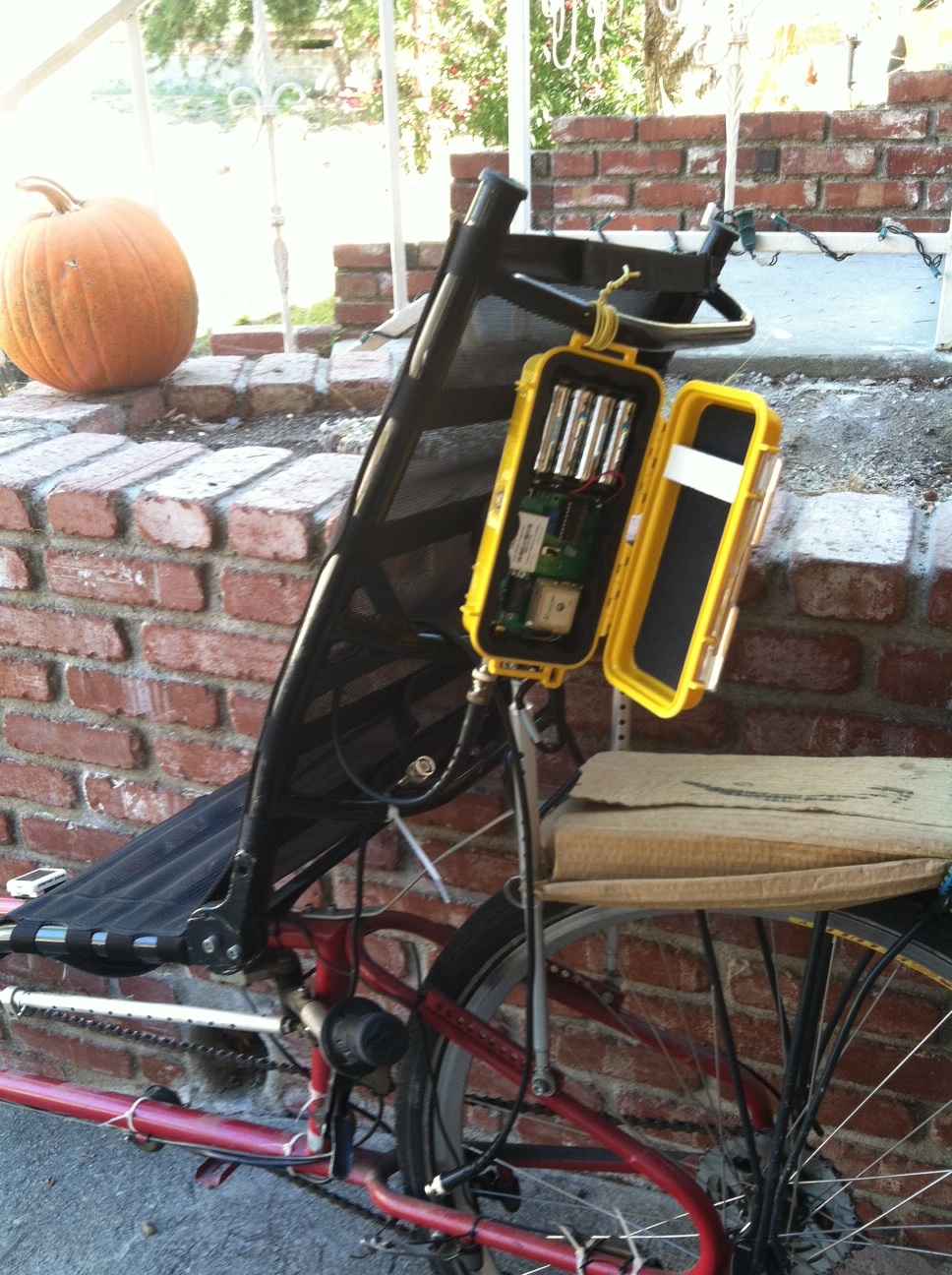
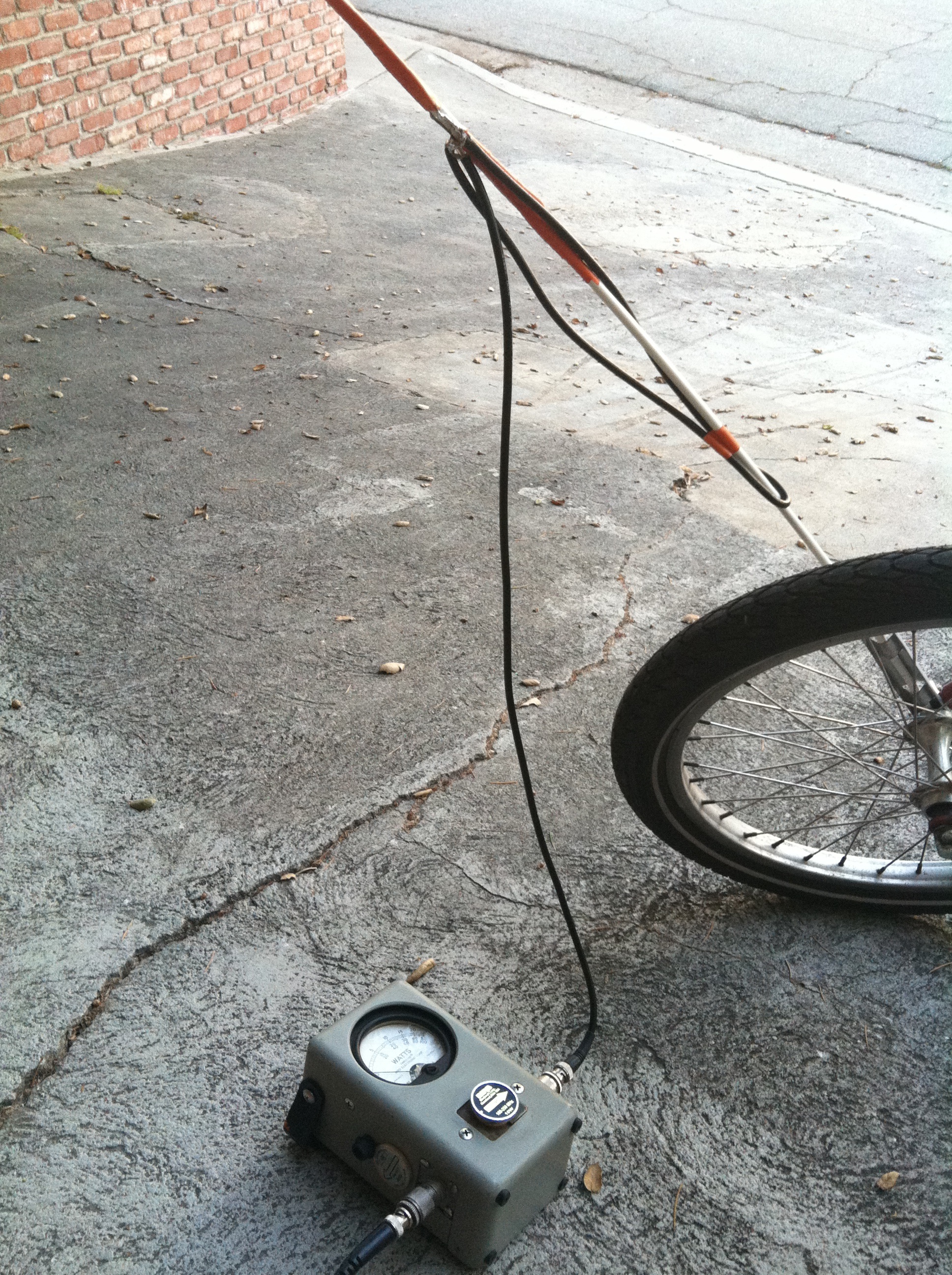
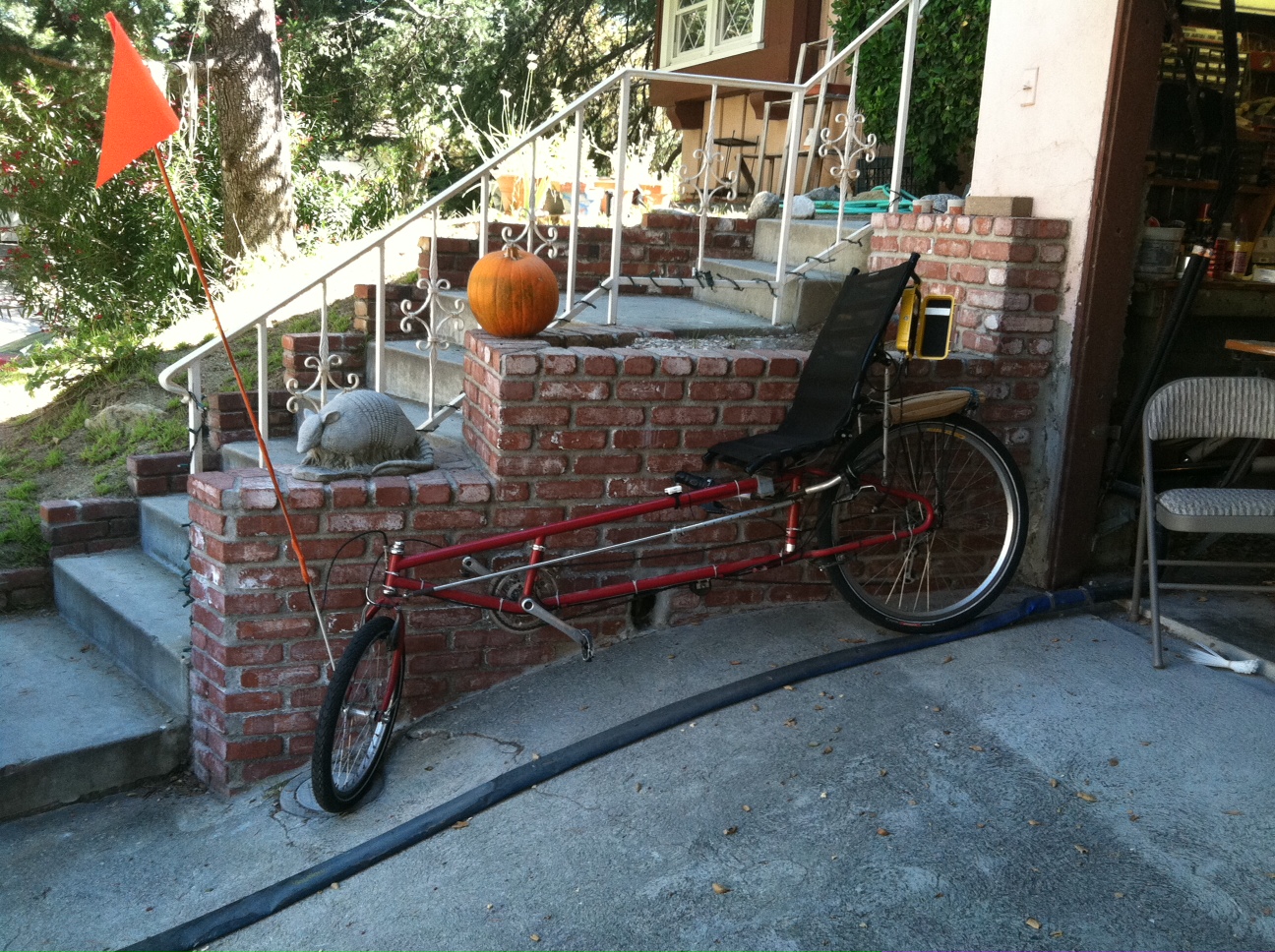
A typical commute to work, as recorded for N5BF-4
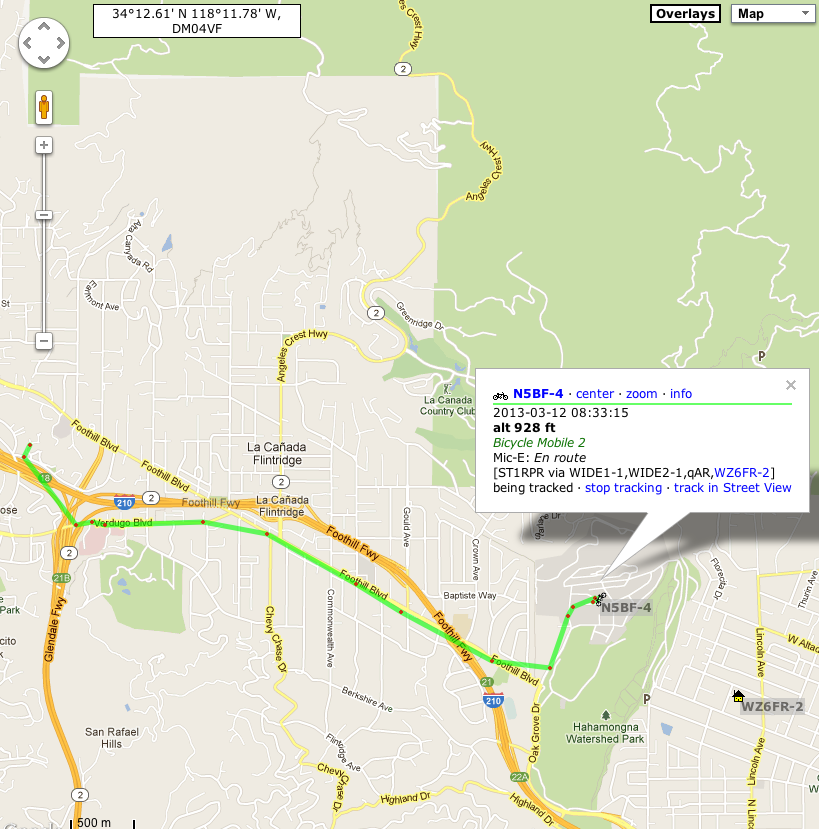
2012 August 22 APRS Ryan Recumbent QRO
Added the old Henry 10W in 50W out amplifier to the bicycle.
Clearly a pain to attach and power but, with WZ6FR-2 nearby, made one
of the only good traces of the "south route" that I've ever had.
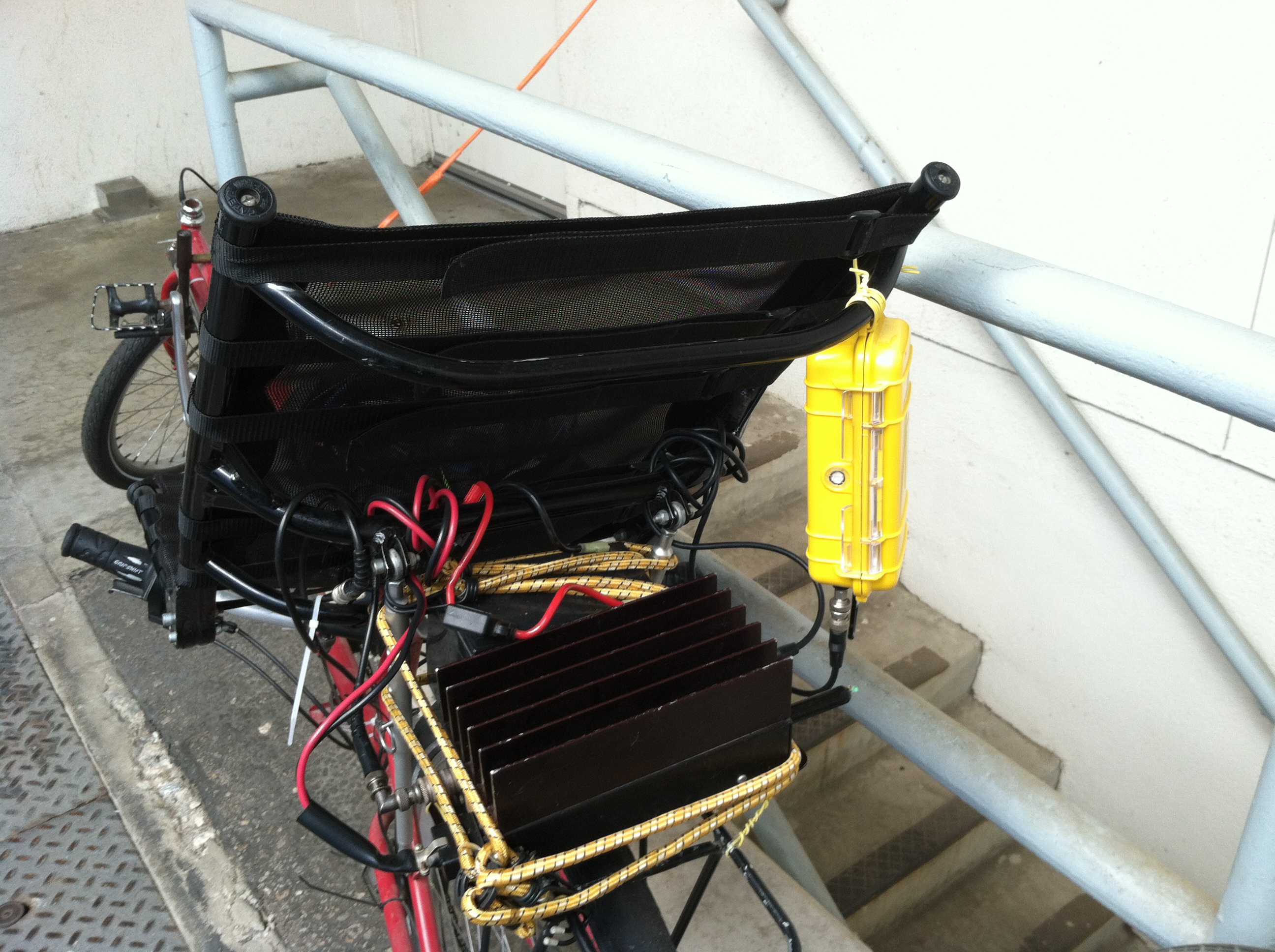
To the right of the amp, under the AIO, is a phono plug with an LED
sticking out the back. The LED is a diode detector to show power
coming out of the amp (has to be shaded or dark out to see the
indication). This turned out to be handy as packet use finished
off the T/R relay after a few weeks of operation. I removed the
T/R relay (after mechanically jamming it on for one ride) and made the
Henry a "transmit only" amp (to match the "transmit only" AIO.
Other problems: Jones plug on the left falling off during
operation. Having to set the backpack on top of it. Of
course, losing the amp was losing everything after the passthrough
relay was removed. Difficult to get the battery, a 12V 12 AH
sealed Lead Calcium battery weighing about ten pounds, in and out for
charging. Only needed every few weeks, but still a lot of
overhead. After a few months of fussing with this, and several
repairs, decided to go back to barefoot and haven't had any problems
yet. The near in node was more helpful than the QRO. Thirty
watts was getting me into Mexico on some transmissions, and often to
Palomar but what one needs for this is consistency, not DX.
Here's the good trace and the related packets.
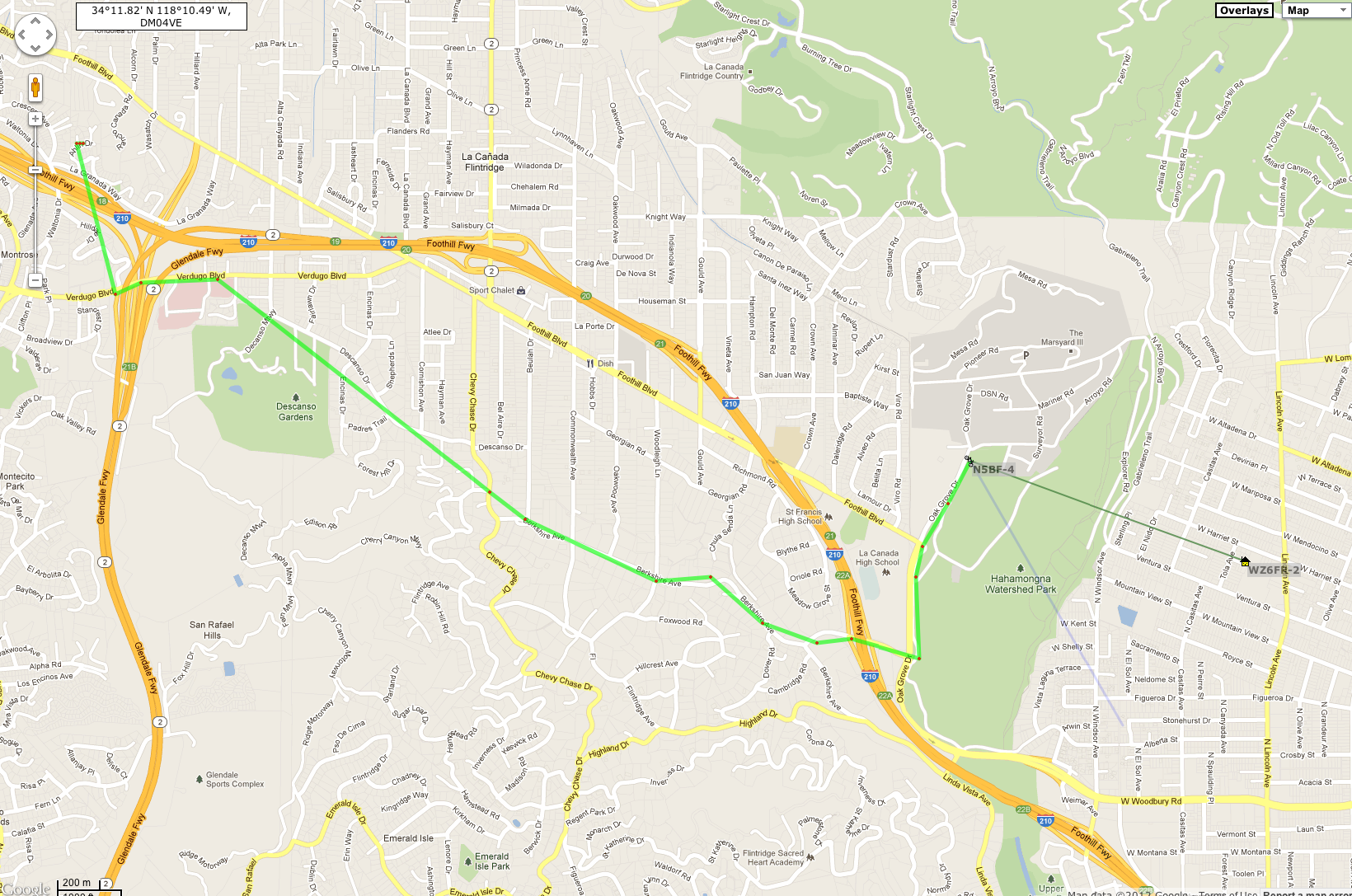
27 / 39 unique
20120822141459,N5BF-4>APT3A2,KF6ILA-10,WIDE1*,WIDE2-1,qAR,N6EX-3:>MT-AIO
v1.2
20120822141539,N5BF-4>APT3A2,N6EX-5*,qAR,N6EX-3:>MT-AIO
v1.2
20120822141634,N5BF-4>ST1RVX,N6EX-5*,qAR,N6EX-3:`.)8l
�b/"8r}Bicycle Mobile 1
20120822141701,N5BF-4>APT3A2,KF6ILA-10*,WIDE1*,WIDE2-1,qAR,W6QAR-1:>MT-AIO
v1.2
20120822141804,N5BF-4>ST1RVX,N6EX-5*,qAR,N6EX-3:`.):l
�b/"8A}
20120822141904,N5BF-4>ST1RVX,KF6ILA-10,WIDE1*,WIDE2-1,qAR,N6EX-3:`.)9l
&b/"8j}
20120822142100,N5BF-4>ST1RVX,KF6ILA-10*,WIDE1*,WIDE2-1,qAR,W6QAR-1:`.)9l
&b/"8j}
20120822142103,N5BF-4>ST1RVY,KF6ILA-10,WIDE1*,WIDE2-1,qAR,N6EX-3:`.);l
/b/"7q}
20120822142302,N5BF-4>ST1RVX,N6EX-5*,qAR,N6EX-3:`.):l
1b/"8L}
20120822142402,N5BF-4>ST1RVX,KF6ILA-10,WIDE1*,WIDE2-1,qAR,N6EX-3:`.):l
<b/"8K}
20120822142535,N5BF-4>ST1RVX,KF6ILA-10*,WIDE1*,WIDE2-1,qAR,W6QAR-1:`.):l
<b/"8K}
20120822143159,N5BF-4>ST1RRY,W6SCE-10*,WIDE2-1,qAR,N6EX-3:`.).l4Lb/"8B}Bicycle
Mobile 1
20120822143258,N5BF-4>ST1RSR,KF6ILA-10,WIDE1*,WIDE2-1,qAR,N6EX-3:`.)&l*sb/"9,}
20120822143530,N5BF-4>ST1RSR,KF6ILA-10*,WIDE1*,KA6DAC-1*,WIDE2*,qAR,W6QAR-1:`.)&l*sb/"9,}
20120822143559,N5BF-4>ST1RSS,KF6ILA-10,WIDE1*,WIDE2-1,qAR,N6EX-3:`.(rlI
b/"8P}
20120822143815,N5BF-4>ST1RSS,KF6ILA-10*,WIDE1*,KA6DAC-1*,WIDE2*,qAR,W6QAR-1:`.(rlI
b/"8P}
20120822144058,N5BF-4>ST1QWX,WIDE1-1,WIDE2-1,qAR,WZ6FR-2:`.(�lgvb/"7z}
20120822144158,N5BF-4>ST1QWQ,WIDE1-1,WIDE2-1,qAR,N6EX-3:`.'vl4Mb/"87}Bicycle
Mobile 1
20120822144223,N5BF-4>ST1QWX,N6EX-1*,KA6DAC-1*,WIDE2*,qAR,W6QAR-1:`.(�lgvb/"7z}
20120822144345,N5BF-4>ST1QWQ,W6SCE-10*,CREBC-1*,WIDE2*,qAR,W6QAR-1:`.'vl4Mb/"87}Bicycle
Mobile 1
20120822144357,N5BF-4>ST1QUU,WIDE1-1,WIDE2-1,qAR,WZ6FR-2:`.'Ml?7b/"8,}
20120822144459,N5BF-4>ST1QUV,KF6ILA-10*,WIDE1*,WIDE2-1,qAR,N6JCM:`.'<lf6b/"8!}
20120822144558,N5BF-4>ST1QTT,WIDE1-1,WIDE2-1,qAR,WZ6FR-2:`.',lSDb/"7H}
20120822144659,N5BF-4>ST1QSY,WIDE1-1,WIDE2-1,qAR,WZ6FR-2:`.&l\cb/"7z}Bicycle
Mobile 1
20120822144722,N5BF-4>ST1QUV,KF6ILA-10*,WIDE1*,WIDE2-1,qAR,W6QAR-1:`.'<lf6b/"8!}
20120822144759,N5BF-4>ST1QTP,WIDE1-1,WIDE2-1,qAR,WZ6FR-2:`.&tl+}b/"7B}
20120822144859,N5BF-4>ST1QSU,WIDE1-1,WIDE2-1,qAR,WZ6FR-2:`.&_l4,b/"7Q}
20120822144952,N5BF-4>ST1QSY,KF6ILA-10*,WIDE1*,KA6DAC-1*,WIDE2*,qAR,W6QAR-1:`.&l\cb/"7z}Bicycle
Mobile 1
20120822145045,N5BF-4>ST1QTP,KF6ILA-10*,WIDE1*,WIDE2-1,qAR,W6QAR-1:`.&tl+}b/"7B}
20120822145058,N5BF-4>ST1QUV,WIDE1-1,WIDE2-1,qAR,WZ6FR-2:`.&`lH!b/"7Y}
20120822145158,N5BF-4>ST1QVT,WIDE1-1,WIDE2-1,qAR,WZ6FR-2:`.&^l+Eb/"79}Bicycle
Mobile 1
20120822145241,N5BF-4>ST1QUV,N6EX-1*,KA6DAC-1*,WIDE2*,qAR,W6QAR-1:`.&`lH!b/"7Y}
20120822145257,N5BF-4>ST1QWU,WIDE1-1,WIDE2-1,qAR,WZ6FR-2:`.&VlS\b/"7s}
20120822145357,N5BF-4>ST1QXV,WIDE1-1,WIDE2-1,qAR,WZ6FR-2:`.&Ol5Nb/"7o}
Also, for a time, went with an informal Byonics recommendation
to try 12 series AA batteries in the AIO instead of 8, that is, 18
volts rest instead of 12. This was a mechanical strain on the
container and didn't help electrically as much as you'd expect.
If you had the whole 18 volts on transmit you'd expect maybe 15 watts
output, which, on very low duty cycle, you'd expect the device to
survive. But, the higher voltage led to higher current draw and,
against the internal resistance of the batteries (plus additional
batteries) the pack voltage drop during key down was still to the 10-11
V range after only a few days of operation. So there was no
worthwhile power increase. Went back to eight AA batteries and
used the long life (expensive) ones. A set of those can last
nearly a year in my type of operation -- two half to whole hour
commutes a few times a week.
2013 March 16 Another Visit to
M-Squared Open House and BBQ
In house antenna boom orthogonal hole driller
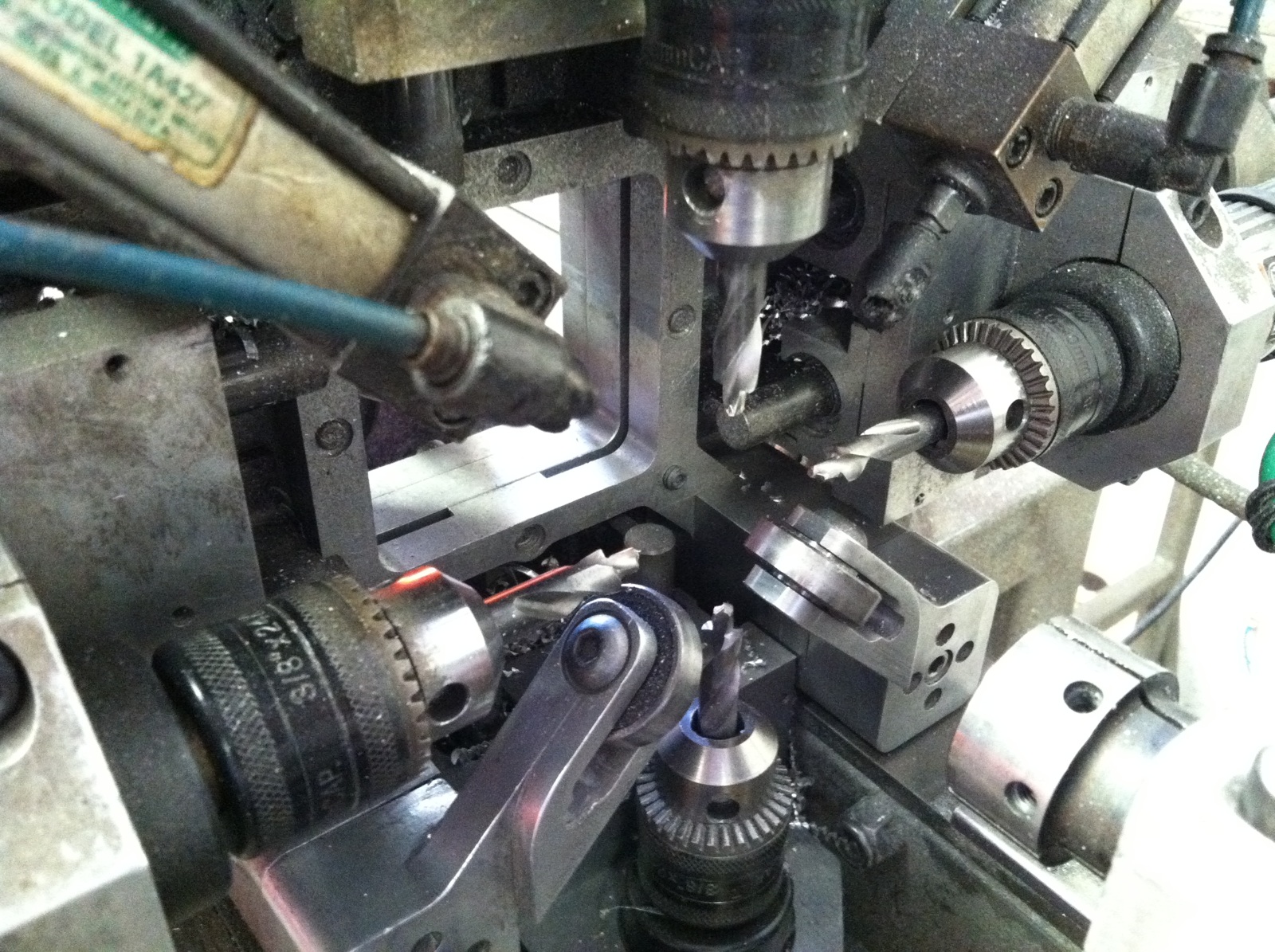
Left overs:
- Operation of or modifiation of station appliances
- TS-680
- Yaseau FT-2800M (backup mobile rig)
- Things done with HTs besides using them for test equipment
